
Hours of operation:
Mon-Fri 8:00AM-5:30PM
Saturday 9:00AM-NOON |


|
|
|
|
|
|
Pest Facts from McDaniel Pest Control
| German Cockroach |
| |
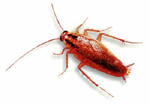 This roach, with two dark brown vertical stripes behind the head, is found throughout the world, thriving wherever man lives, eating the same foods, sharing the same habitats. It is commonly found in restaurants, kitchens and stores where food, moisture and harborage are abundant. German roaches are rarely seen outdoors. Populations build rapidly from egg capsules being produced about every 20-25 days. Each capsule contains 30-35 eggs. The young mature in 4-6 months. German roaches contaminate food, leave stains, create foul odors and carry disease organisms. They hide during the day, closely packed in small cracks and crevices near food and water. (Length: 1/2" – 5/8") This roach, with two dark brown vertical stripes behind the head, is found throughout the world, thriving wherever man lives, eating the same foods, sharing the same habitats. It is commonly found in restaurants, kitchens and stores where food, moisture and harborage are abundant. German roaches are rarely seen outdoors. Populations build rapidly from egg capsules being produced about every 20-25 days. Each capsule contains 30-35 eggs. The young mature in 4-6 months. German roaches contaminate food, leave stains, create foul odors and carry disease organisms. They hide during the day, closely packed in small cracks and crevices near food and water. (Length: 1/2" – 5/8") |
| |
|
| American Cockroach |
| |
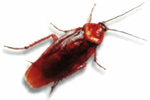 One of the groups commonly referred to as "Palmetto Bugs", the American Cockroach is the largest of the roaches infesting homes. Hospitals and warehouses are also targets. It has reddish brown wings and is a good flyer. American Cockroaches often invade from sewer systems and heavily mulched areas. Grocery packages are also a favorite transport. The female attaches the egg capsule, containing about 12 eggs, in high areas in garages, closets, utility rooms and fireplaces. The young mature in 12 months. Found nearly anywhere in the house, American Cockroaches contaminate food, carry disease, damage book bindings, fabrics and wallpaper. (Length: 1 1/2" – 2") One of the groups commonly referred to as "Palmetto Bugs", the American Cockroach is the largest of the roaches infesting homes. Hospitals and warehouses are also targets. It has reddish brown wings and is a good flyer. American Cockroaches often invade from sewer systems and heavily mulched areas. Grocery packages are also a favorite transport. The female attaches the egg capsule, containing about 12 eggs, in high areas in garages, closets, utility rooms and fireplaces. The young mature in 12 months. Found nearly anywhere in the house, American Cockroaches contaminate food, carry disease, damage book bindings, fabrics and wallpaper. (Length: 1 1/2" – 2") |
| |
|
| Flea |
| |
 Fleas are small, hard-bodied, wingless insects with a flattened body and legs adapted for jumping on to a host. The cat flea, most commonly encountered in Florida, seeds mammals for the blood meal needed to sustain them. They can be a direct health hazard, transmitting disease and tapeworm. Humans are often attacked when other food sources aren’t available. Their bite leaves a red, itchy spot on the skin. Their saliva is irritating to the host, causing dermatitis and hair loss in allergic animals. (Length: 1/32" – 1/16") Fleas are small, hard-bodied, wingless insects with a flattened body and legs adapted for jumping on to a host. The cat flea, most commonly encountered in Florida, seeds mammals for the blood meal needed to sustain them. They can be a direct health hazard, transmitting disease and tapeworm. Humans are often attacked when other food sources aren’t available. Their bite leaves a red, itchy spot on the skin. Their saliva is irritating to the host, causing dermatitis and hair loss in allergic animals. (Length: 1/32" – 1/16") |
| |
|
| Brown Recluse Spider |
| |
 The brown recluse is a brownish spider with a distinctive violin-shaped mark behind its eyes, which has earned it the name The brown recluse is a brownish spider with a distinctive violin-shaped mark behind its eyes, which has earned it the name
"fiddle-backed" spider. It is found in undisturbed areas such as sheds, garages and dark closets. Garments left hanging for some time are favorite spots. Their bite causes a severe systemic reaction that develops a crust and a surrounding red zone. The crust falls off, leaving a deep crater which may take several months to heal. The crater may require extensive medical attention.
(Length: 1/4" – 1/2") |
| |
|
| Argentine Ants |
| |
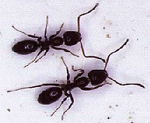 These medium size ants are uniformly brown and trail in large numbers. They compete aggressively with other ant species for food and nesting sites and can drive most other ant species out of their territory. Their nests have large numbers of individuals and a high percentage of queens. Because of their aggressive nature, these ants will develop into super-colonies in many urban situations with the colony spread across large areas. It is not uncommon to find Argentine ants spread across entire neighborhoods. Their nests are often under heavy leaf litter, under wood on the ground, at the base of trees and in planters and mulch. They prefer the outdoors, but will enter houses looking for food, water and warmth. They particularly like sweet foods. (Length: 1/11" -1/10") These medium size ants are uniformly brown and trail in large numbers. They compete aggressively with other ant species for food and nesting sites and can drive most other ant species out of their territory. Their nests have large numbers of individuals and a high percentage of queens. Because of their aggressive nature, these ants will develop into super-colonies in many urban situations with the colony spread across large areas. It is not uncommon to find Argentine ants spread across entire neighborhoods. Their nests are often under heavy leaf litter, under wood on the ground, at the base of trees and in planters and mulch. They prefer the outdoors, but will enter houses looking for food, water and warmth. They particularly like sweet foods. (Length: 1/11" -1/10") |
| |
|
| Earwig |
| |
 Earwigs were named by a superstition that the insect would crawl purposely into the ears of sleeping people. More easily recognized by its forceps-like tail appendage, the earwig is a major garden pest, as well as an annoying household pest. It is one of the few insects that take care of its young. Earwigs feed on green plants, and other vegetation, and do little damage indoors. The pinch of their forceps is neither painful nor poisonous, but does an effective "scare" job. (Length: 3/8" to 1") Earwigs were named by a superstition that the insect would crawl purposely into the ears of sleeping people. More easily recognized by its forceps-like tail appendage, the earwig is a major garden pest, as well as an annoying household pest. It is one of the few insects that take care of its young. Earwigs feed on green plants, and other vegetation, and do little damage indoors. The pinch of their forceps is neither painful nor poisonous, but does an effective "scare" job. (Length: 3/8" to 1") |
| |
|
| Bed Bugs |
| |
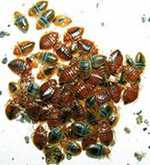 Bed bugs are small wingless insects that feed solely upon the blood of warm-blooded animals. Hatchling bed bugs are about the size of a poppy seed, and adults are about 1/4 of an inch in length. From above they are oval in shape, but are flattened from top to bottom. Their color ranges from nearly white or a light tan to a deep brown or burnt orange. The host’s blood may appear as a dark red or black mass within the bug’s body. Because they never develop wings, bed bugs cannot fly. When disturbed, bed bugs actively seek shelter in dark cracks and crevices. Bed bugs are small wingless insects that feed solely upon the blood of warm-blooded animals. Hatchling bed bugs are about the size of a poppy seed, and adults are about 1/4 of an inch in length. From above they are oval in shape, but are flattened from top to bottom. Their color ranges from nearly white or a light tan to a deep brown or burnt orange. The host’s blood may appear as a dark red or black mass within the bug’s body. Because they never develop wings, bed bugs cannot fly. When disturbed, bed bugs actively seek shelter in dark cracks and crevices.
(Length: up to 1/2") |
| |
|
| Roof Rat |
| |
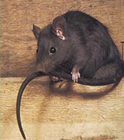 Black or brown in color, the roof rat is slender with a tail that is usually longer than the combined length of its head and body. They are nocturnal and prefer to forage for food above ground in elevated areas indoors and outdoors. They are excellent climbers and often use trees and utility lines to reach food and enter buildings. They are a plant and animal eater, but are very fond of fruit, especially oranges. They nest inside and under buildings, or in piles of rubbish or wood. Black or brown in color, the roof rat is slender with a tail that is usually longer than the combined length of its head and body. They are nocturnal and prefer to forage for food above ground in elevated areas indoors and outdoors. They are excellent climbers and often use trees and utility lines to reach food and enter buildings. They are a plant and animal eater, but are very fond of fruit, especially oranges. They nest inside and under buildings, or in piles of rubbish or wood.
(Length: 7" – 8" head to tail) |
| |
|
| House Mouse |
| |
 Light brown or light grey in color, the house mouse is small and slender with large ears and small eyes. They have a keen sense of hearing, taste, smell and touch. While they are mostly active at night they can be seen during the day searching for food. Although they usually feed on cereal grains, they will eat almost anything. They nest within structures or burrows and establish a "territory" near food sources, generally 10 to 30 feet from their nest. The house mouse is a prolific breeder. (Length: 2" – 4" head to tail) Light brown or light grey in color, the house mouse is small and slender with large ears and small eyes. They have a keen sense of hearing, taste, smell and touch. While they are mostly active at night they can be seen during the day searching for food. Although they usually feed on cereal grains, they will eat almost anything. They nest within structures or burrows and establish a "territory" near food sources, generally 10 to 30 feet from their nest. The house mouse is a prolific breeder. (Length: 2" – 4" head to tail) |
| |
|
|
|
|
|
|
|
|
|
|
|